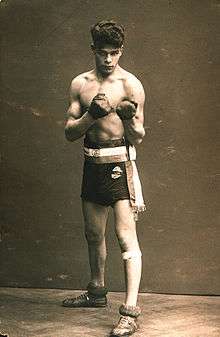Johann Trollmann
Johann Wilhelm "Rukeli"[1] Trollmann (27 December 1907 – April 1944) was a German Sinto boxer.[2]
| Johann Trollmann | |
|---|---|
 Trollmann photographed in 1928. | |
| Statistics | |
| Real name | Johann Wilhelm Trollmann |
| Nickname(s) | Rukeli |
| Nationality | German |
| Born | 27 December 1907 Wilsche by Gifhorn |
| Died | 9 April 1944 (aged 36) Wittenberge concentration camp |
Trollmann became famous in the late 1920s.[3] On 9 June 1933, he fought for the German light-heavyweight title and although he clearly led by points over his opponent Adolf Witt, the fight was judged "no result".[3] The audience rebelled, and the Nazi officials were forced to acknowledge Trollmann as the victor. Six days later, however, he was again stripped of the title. A new fight was scheduled for 21 July, with Gustav Eder as Trollmann's opponent. Trollmann was threatened that he had to change his "dancing" style or lose his licence. Trollmann, of Sinti heritage, arrived the day of the match with his hair dyed blonde and his face whitened with flour, the caricature of an Aryan. He took the blows of his opponent as he was asked for five rounds before he collapsed.[4]
The persecution of Sinti and Roma in Germany dramatically increased in the following years.[5] Sterilization often preceded their internment in concentration camps, and Trollmann too underwent this operation. In 1939 he was drafted into the Wehrmacht, and fought on the eastern front.[6] He was wounded in 1941 and was returned to Germany as a result.[7] The Gestapo arrested him in June 1942, and he was interned in Neuengamme concentration camp. He tried to keep a low profile, but the camp commandant had been a boxing official before the war and recognized Trollmann.[7] He used Trollman as a trainer for his troops during the nights. The prisoners committee decided to act, as Trollman's health deteriorated. They faked his death and managed to get him transferred to the adjacent camp of Wittenberge under an assumed identity. The former star was soon recognized and the prisoners organized a fight between him and Emil Cornelius, a former criminal and hated Kapo (a prisoner given privileges for taking on responsibilities in the camp, often a convict working for a reduced sentence or parole). Inevitably Trollmann won. Cornelius soon sought revenge for his humiliation and forced Trollmann to work all day until he was exhausted, before attacking and killing him with a shovel. Trollmann was 35 years old.[1]
Rehabilitation and Commemoration

In 2003 the German boxing federation officially decided to recognize Trollmann as the winner of the 1933 championship.[1]
On 9 June 2010, the anniversary of his championship fight,[8] the German artist collective Bewegung Nurr erected a temporary memorial "9841" in the Berlin Victoria Park to honor Trollmann.[9] The memorial was also displayed the following year in Hannover and in Dresden in 2012 for six weeks. The title refers to Trollmann's prison number.[1]
In 2015 the Italian alternative rock band C.F.F. e il Nomade Venerabile released the song Come fiori dedicated to the boxer Johann Wilhelm Trollmann "Rukeli", the video clip is available on YouTube. From this song is born the theathral show My Inv(f)erno... gypsy life, directed by Maurizio Vacca, that opens the X edition of the International TeatroLab Festival at the Tagliavini theater in Novellara in March 2019.
In 2016 Dario Fo, recipient of the 1997 Nobel Prize in Literature, published the book Razza di zingaro based on Trollmann's life.
References
- Day Trust, Holocaust Memorial. "Johann 'Rukeli' Trollmann". Retrieved 4 January 2017.
- "9841-Johann Trollmann-Temporäres Denkmal - Home". trollmann.info. Retrieved 2018-02-21.
- "Lebenslauf des Johann "Rukeli" Trollmann | Johann Rukeli Trollmann e.V." Johann Rukeli Trollmann e.V. 2014-05-05. Retrieved 2018-02-21.
- "Podcast Episode 297: A Sinto Boxer in Nazi Germany". Futility Closet. 2020-05-25. Retrieved 2020-05-26.
- "Sinti and Roma – Holocaust Teacher Resource Center". www.holocaust-trc.org. Retrieved 2018-02-21.
- "9841-Johann Trollmann-Temporäres Denkmal - History". trollmann.info. Retrieved 2018-02-21.
- "Stolpersteine in Berlin | Orte & Biografien der Stolpersteine in Berlin". www.stolpersteine-berlin.de. Retrieved 2018-02-21.
- "BEWEGUNG NURR". www.nurr.net. Retrieved 2018-02-21.
- "A Fight for Memory: Monument Honors Sinti Boxer Murdered by the Nazis". Spiegel Online International. June 30, 2010. Retrieved 11 October 2013.